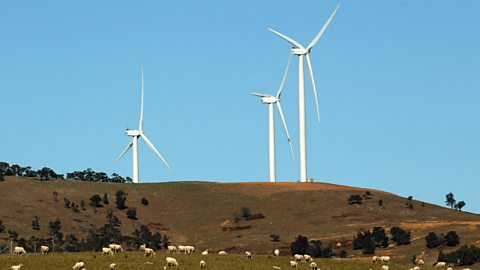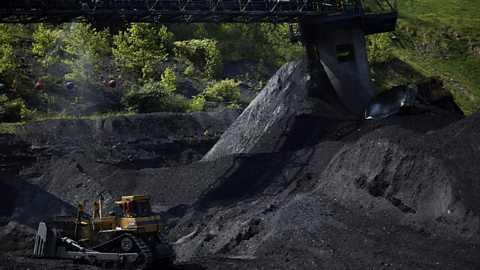Strategies to increase energy supply
As the global population continues to increase and existing fuel supplies begin to run out, countries will have to find ways to increase energy supplies.
Renewable energy
renewableEnergy sources that are replenished and not exhausted, eg solar power. technologies offer a way to increase energy supplies, however they are often more expensive or less efficientPerforming in the best possible manner with little time, money or energy wasted. at producing energy than fossil fuelNatural, finite fuel formed from the remains of living organisms, eg oil, coal and natural gas.. Therefore they may require government subsidies.
Biomass
biomassThe dry mass of an organism. is recently-formed material derived from living things, eg chicken droppings. energy from waste plantA place that burns non-renewable waste in order to generate electricity. burn biomass and non-recyclable rubbish to generate electricity. The UK has many 'energy from waste' plants, eg Allington Quarry in Maidstone, Kent.
Hydroelectric power (HEP)
hydroelectric power (HEP)Energy generated from fast-flowing water. is generated when river water is trapped behind a damA structure built to slow down or stop the flow of a river. This creates a large lake or reservoir, which can be used for water supply, leisure or electricity generation. and used to turn turbineRevolving machine with blades that are turned by wind, water or steam. Turbines in a power station turn the generators.. The UK generates around 2% of its electricity this way. Most suitable locations for dam building have already been used.
Wave power and tidal power
The UK is an island nation, yet it generates very little energy using the sea. Wave energy harnesses the power of small movements on the surface of the sea. The technology is new and currently expensive. Tidal energy harnesses larger movements of the tides. There are plans for tidal lagoonA shallow area of water separated from the sea by a bar or spit. to be built in the UK, and permission has been granted to begin a £1.7 billion tidal lagoon project in Swansea Bay.
Geothermal
geothermalEnergy from the heat of the Earth. power uses heat within the Earth to generate electricity. This is easier in other countries where geothermal heat is more accessible, eg Iceland. However, drilling has begun on a geothermal power plant at the Eden Project in Cornwall which will take energy from heat in underground granite rocks. ground source heat pumpA system that captures solar energy stored in the surface of the Earth and converts it to electricity. are a similar idea, but they use the heat from the Sun that is stored within the surface of the Earth.
Solar power
The UK government wants to triple the use of solar powerEnergy generated from the heat of the sun. by 2030. solar panelA piece of equipment used to generate electricity by capturing heat from the sun. can be fitted onto buildings or within fields. They turn sunlight into electricity. New technology means solar panels are able to generate electricity on cloudy days, which would be good for the UK.
Wind power
wind powerEnergy generated from the moving air. is when wind turbines convert air movements into electricity. In the UK wind speeds are consistent and so this is a good way to generate electricity. The UK generates more wind energy using turbines on the land (onshore). As an island nation, the UK could build more turbines in the sea (offshore) though these are more expensive.

Non-renewable energy
Global energy use is still dominated by non-renewableA resource that cannot be replaced when it is used up, such as oil, natural gas or coal. energy. The use of non-renewable energy can be made more efficientPerforming in the best possible manner with little time, money or energy wasted.. This could increase energy supplies as less fuel would be used.
Fossil fuels
Coal and gas power stations can now re-use wasted heat in. These are called combined-cycle systems. Re-using heat makes the most out of the fossil fuels. Also, some power stations now burn small amounts of biomassThe dry mass of an organism. alongside fossil fuels. This is called co-firing and it makes the fossil fuel last longer.

Fracking
frackingBreaking rock deep underground by injecting liquid under pressure so that many tiny cracks form. could exploit shale gas and oil, which would increase supplies of fossil fuels. In 2019, the UK government ended its support for fracking in England. The locations that were identified as suitable for fracking included parts of Yorkshire, Lancashire, Lincolnshire, Leicestershire, Nottinghamshire and Derbyshire, which are believed to be some of the most productive areas for shale gas.
Some of the UK locations are within the boundaries of National Parks or Environmentally Sensitive Areas, and the proposals have created some land use conflicts.
Nuclear power
uranium fuel rodThe fuel for nuclear power stations. still have some uranium left within them after they have been used. Reprocessing recovers the uranium from spentSomething that has been used up. fuel rods so that it can be reused. This doesn't create new supplies of uranium, but it does use the existing supplies more efficiently. This means that uranium supplies will last longer.